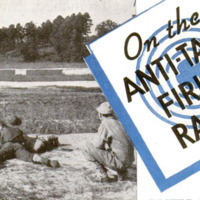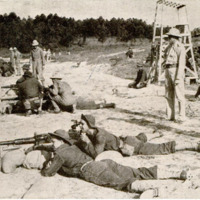WHILE American tanks endure their baptism of fire on Libyan sands, Uncle Sam’s young men are learning how to stop these land battleships to the accompaniment of a terrific tattoo of anti-tank weapons at Camp Wheeler, Georgia. Tracer bullets stream from 50-caliber machine guns to rip through targets thatrace, crawland double back unexpectedly on a winding track hundreds of yards distant. The armored tank has been the Goliath of land warfare in World War II, terrifying to the infantry soldier and a destroyer of backline communications. Defense against them is both passive and active. Passive defense is primarily an effort to obstruct their movement or hide from them. The army digs traps, sets up wooden posts to block their advance; soldiers dig “fox holes” in which they hide safely as tanks roll over them. But the best way to stop a tank is to attack it. This means guns with penetrating fire, capable of biting through several inches of steel, as well as trained personnel to operate them. We have such guns - 37 millimeters and 75s, in addition to heavy artillery. To a lesser extent the .50-caliber machine gun is effective against light tanks and lightly armored vehicles. It is the first gun an Infantry trainee uses on the antitank firing range. At Camp Wheeler, Infantry Replacement Center near Macon, Ga., the new army is schooled in the elementary use of antitank guns. The range is in a heavily wooded area. It has to be. The fire from .50-caliber guns creates a danger area 9,500 yards behind the targets. The range slopes up to a summit 700 yards away. Down the line, instructors give the ready signal. Over a loud speaker a voice barks the firing orders. Then, on the slope, three small white objects start moving across the range. You take aim, your hand flicks the trigger, a tracer bullet streaks across the clearing toward its goal - you hope. If you're off, you hastily correct the error and bang away again. Let’s take a look at those targets. They measure 3 1/2 by 6 feet, about the size of the vital portion of a tank. There are three of them, one for each gun, and they move on tracks, the farthest at a constant distance of 700 yards, the nearest at 400 yards, and a middle target moving angularly between the others. Each target is drawn by an endless cable, driven from the rear axle of an old truck. Stripped to its chassis and set up in the control house, the truck can move the targets at 5 to 35 miles an hour. The control house lies buried at the top of the slope, hidden from the firing line. Walled by one foot of steel-reinforced concrete, it is buffered ten feet ahead by another two-foot wall of concrete, between which is enough sand to sink a dredge. This sandwich of concrete, steel, and sand will withstand the fire of seventy-fives. The elevated control stand overlooks the line of machine guns, with a clear view of the targets. An officer, in telephone contact with the control house, sits before a microphone and issues orders to the gun crews. Noncommissioned officers behind the gunners see that orders are followed. Soldiers are trained in the firing routine until it becomes automatic. When the control officer calls “Range!” they respond with the yardage on their target, simultaneously adjusting their guns to the correct range. “Tank!” - the description of the target - is the second order. As soon as the gunners repeat this, the command “One lead” or “Two leads” follows, according to the speed of the tank and its distance. The faster a tank goes, the greater the lead he has to take in advance of the target. Then comes “Track left!” or “Track right!”, indicating the direction the targets will move. The last command is “Commence Firing!” For weeks before the trainces are permitted to try their skill, they spend arduous hours on cardboard targets, using their imagination for ammunition. They learn the principles of firing the rifle, the pistol, the light machine gun, heavy machine gun, and mortars. They get the feel of a gun, become used to the shock of fire, acquire a sense of timing and distance and learn the construction and operation of each mechanism. When they finally go up for their turn on the anti-tank guns, they find the weeks of practice have not been in vain. They're pretty good marksmen.




